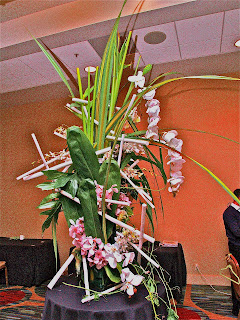Last week Flower Design participated in the Event Planners’ Showcase, hosted by the Blaisdell Manor. The theme was predominantly, but not exclusively, wedding receptions. We especially enjoyed seeing the work of Christine Anderson, owner of Christine’s Floral Touch. She, of course, uses fresh flowers, and does lovely work. Some of our work there has already been displayed on our face book page. (We also enjoyed the first-rate food from the Manor’s kitchen.)
 |
| We showed this vase in a previous posting. Now containing an arrangement of green calla lilies, heliconia and vanda orchids, it adds elegance wherever it is placed, |
 |
| Here is the vase we used in the Art in Bloom show, now sporting an arrangement of calla lilies and red ginger. It is flanked by sophisticated compositions of stock and ranunculus. |
 |
| This montage is perfect for the bay window of the Manor's Georgian interior. |
In addition to permanent botanicals, we exhibited a product that has not really caught on, yet, in the United States, but is very popular in other parts of the world. Fully two-thirds of the “Likes” that we get on our business page come from abroad, and most of those are from Asia. We see styles and trends indigenous to other cultures. Beth is especially interested in the Japanese custom of using preserved flowers. These were once living blossoms that have been chemically treated to preserve their original look and feel.
 |
| This small composition of hydrangea and roses in a martini glass is the ideal accent for a small bar table. |
 |
| This formal table setting is adorned with a centerpiece composed of preserved and dried elements. It could be adapted for any holiday or special occasion. |
 |
| Another accent in a martini glass: white rose petals around the rim with a red rose and red dyed hydrangea in the center. |
 |
| Here orchids, roses and a pink calla lily are nestled among some greens--all preserved. Shown here in a hand made Ikebana vase, this is a traditional Japanese composition. |
[All you non-chemists should skip this paragraph. Preserved flowers have had their water extracted, leaving a carbohydrate substrate with active hydrogen atoms. The substrate is then infiltrated with reactive polymer acetals which link to the hydrogen atoms of the substrate to form three-dimensional polymeric networks. Whew.]
 |
| Another typical preserved Japanese arrangement: colored roses and hydrangea with gypsophilia and ferns in a hand thrown pot. |
Certain flowers respond to this treatment better than others. The most commonly preserved blossoms are roses, calla lilies, some orchids, gardenias and carnations. Flowers subjected to this procedure almost always have their stems removed. I imagine this is because the stems have thicker tissue and will not dry out as thoroughly as the blossom. To assemble these blooms into an arrangement then requires the stem to be replaced. This involves a technique of wrapping fine florists’ wire securely around the base of the blossom and then wrapping the wire with green florists’ tape to simulate a stem. This simulation does not look very authentic, so arrangements and bouquets are contrived to conceal the stems. When this is done skillfully, the result is a realistic looking floral composition. Because the blossoms are delicate and the wire is so fine, producing a quality product requires much, much practice.
The advantage these flowers offer is their longevity. Preserved flowers retain their look and feel for years. Some vendors claim the fresh appearance lasts forever. The technology is too new to support that claim, but experience shows that there are no signs of deterioration after three years. This is the ideal solution for the bride who wants to know how to preserve her wedding bouquet as a long-term keepsake. It is preserved before the wedding and, with proper care, will last for years.
 |
| A bridal bouquet with pink and white roses and some greens added for contrast. With minimal care, this bouquet will appear unchanged for years, both visually and texturally. |
Interestingly, this is a technique the Japanese continue trying to refine. There is a new patent for preserving flowers that uses esters (certain kinds of fat) in the preservation process. The patent claims to do a better job of retaining the original colors of the flowers. We are looking for sources that use this method, but the technology is very new and we haven’t been successful in locating a vendor selling specimens processed this way.
I did not originally plan to provide floral arrangements for weddings. That is a big job and floral design was to be a hobby that allowed me to express my creative side without becoming a full-time proposition. However, I will want to develop and maintain the skill of working with this interesting product and, so, may occasionally try my hand at composing a bridal bouquet. When expertly made, they are as beautiful as any fresh bouquet. I recently read a bride’s testimonial about her florist in which the bride complimented the freshness of the flowers in her bouquet by saying they still looked good five days after the wedding. I believe brides who carry preserved bouquets will sing these praises five years after the wedding.
In addition to wedding accessories, The Japanese use preserved flowers in small, decorative arrangements. These can be used as accent pieces in the home and are frequently given as gifts. The aesthetic conventions of these compositions are uniquely Asian, but I really like them. You will see the Japanese influence on arrangements on our web site from time to time, much like the little red purse on this page.
 |
| Hydrangea and red roses with baubles in the form of a small purse constitute a typical Japanese decorative accoutrement. |







